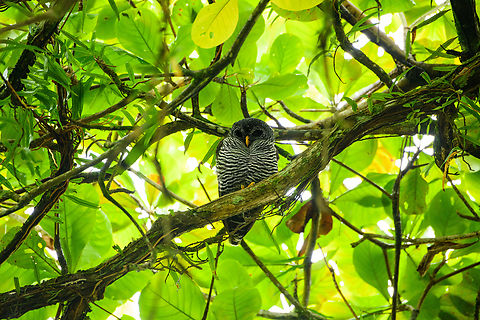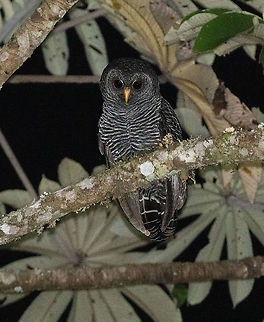
Appearance
The black-banded owl is medium-sized, blackish all over and densely striated with horizontal, wavy, white bars. A black face mask encircle its eyes. It has a rounded head with no ear tufts, and a yellow-orange bill and feet. The tail is sooty-brown, with 4 to 5 narrow white bars and a white terminal band. Primary feathers are significantly darker than the rest of its plumage. Black bristles and feathers are found around the bill and along the leg to the base of the toes.
Distribution
Its natural habitats are varied subtropical or tropical forests ranging from lowlands to areas of medium altitude, and it has been found in Argentina, Bolivia, Brazil, Colombia, Ecuador, French Guiana, Guyana, Paraguay, Peru, Suriname, and Venezuela.Habitat
Black-banded owls are mostly found below an elevation of 500m, with rare records of them at up to 1,400 m. They inhabit various types of forests throughout the South-American landscape, mostly tropical and subtropical forests. In Ecuador they were almost exclusively recorded in the humid forest of the North-East, they were also found in the Atlantic, igapò, and terra-firme forests of Brazil, "Araucaria" forests, and man‐made or disturbed habitats, such as clearings, agricultural land and suburban areas.Reproduction
Not much is known either on the reproduction of black-banded owls. The first description of nesting was reported in 2013. It reported that during the incubation period, from September to November, the egg was incubated all day and almost all night, being left alone only for short bouts of 5–10 min. The same behaviour was observed for at least three weeks following hatching. It is assumed that the female did all the incubation and brooding, congruous with all other owl species studied so far. Both parents actively defended their nest, and the breeding pair most likely excluded other owl species from the center of their territory.Similar to other Ciccaba and Strix owls, the black-banded owl has a clutch size of one nestling, and the nest was situated among forked branches and not in a cavity. Black-banded owls can use the same tree fork for their nest in following years, however they may not breed consecutively.
Food
Little information is available on the food habits of this species, but bats have been found in the stomachs of adult birds and they have been observed eating and feeding moths to their nestlings.The black-and-white owl, the closest relative of the black-banded owl, has been seen capturing large insects, such as beetles, grasshoppers, and cockroaches. As for vertebrate prey, they fed on bats while Mottled Owls, another Ciccaba species, ate predominantly small rodents.
References:
Some text fragments are auto parsed from Wikipedia.